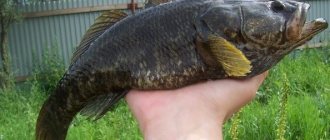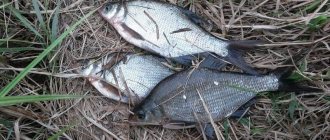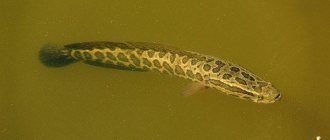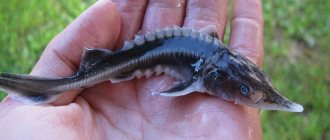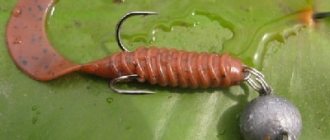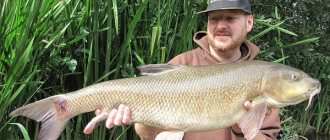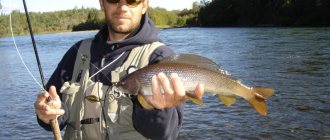How to catch a barbel? And what kind of gear is needed for this? This question is asked by any fisherman going to catch barbel. The barbel is a strong and hardy fish, and in addition, the fast current further increases the load on the equipment. For this reason, it is much more reasonable to use a long, 8-9 meter rod with guide rings and a spinning reel used when fishing with “running” equipment. So, join us and learn all the intricacies of barbel fishing and what gear is needed for barbel fishing, how to feed barbel and what baits are needed for barbel fishing.
In a shallow mountain river, it is difficult for large fish to hide from the watchful eyes of a fisherman. But there are species of fish that, it seems, not only do not want to hide, but rather, on the contrary, try to attract attention to themselves by appearing above the water. On a hot afternoon, watch the rocky rapids with a fast current, followed by deep, calm water. You may be able to spot golden-bronze specimens jumping out of the water, making loud snorting noises. Look carefully into the clear water, illuminated by the summer sun, through which you can see the uneven bottom covered with pebbles. Perhaps you will notice the dark edge of the tail, disturbing the water, like the propeller of a motor boat, and the looming shadow of a large fish with its snout hidden in the rocks. This is a barbel, because it is he who organizes such games. The barbel examines the river bed along its entire width, not even missing shallow water. But it is not possible to catch it everywhere, so you should look for suitable places to cast a fishing rod, for example, a longitudinal depression in the bottom, since there you can hold the bait longer, or deep, calm water behind a rapid is the natural habitat of a large barbel. In addition to mountain rivers, it also lives in the middle sections of large lowland rivers. In some “trout” rivers with fast currents, barbel can be caught using a spinning rod, but for float adherents, fishing with plant bait remains and only in those rivers where this is not prohibited by law. In large lowland rivers, barbel is searched for in fairly fast currents, near a rocky or pebble bottom, near boulders, along fascines and dams, in deep gutters with fast currents, and along washed-out banks.
Where and when to catch barbel
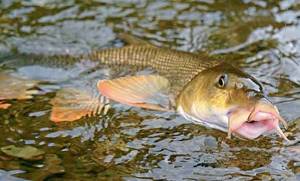
- The habitat of the longhorned beetle is Western Europe, South and West Russia. The barbel is very common in the rivers of the Caucasus, the Kuban and its tributaries. It is found in rivers flowing into the Caspian, Black and Azov seas.
- Inhabits riffles, pebble and sandy bottoms, fast currents, and great depths.
- The barbel is a schooling fish; schools constantly migrate in search of food.
- The barbel feeds mainly from the bottom, but can also rise.
- The best period for catching barbel is summer, especially June. But fishing can begin from spring to autumn. The most active bite is observed at night.

Nutrition and reproduction
The food of this river inhabitant consists mainly of bottom dwellers. He goes in search of food at dawn and after sunset, because he does not like lit places. The barbel prefers to feast on worms, mollusks, crustaceans, larvae, plants, and the eggs of other fish. During periods of flood, myrons can be found in shallow water. They are attracted to the shores of floodplain meadows by animal remains and coastal plants. In summer they are occasionally found on sandbanks. You can identify a barbel by its fast and dexterous movements; it is also capable of jumping out of the water.
To learn more:
Rudd: description of fish and differences from roach
Sexual maturity in males occurs in the second or third year, in females a year later. The fish prefer a solitary and sedentary lifestyle, but during the wintering and spawning periods they unite in schools. Migrations also occur due to the search for clean water. In May-June, a string of madders rises up the river. The eggs are laid in deep water with fast currents on a sandy or rocky bottom. From 15 to 45 thousand larvae are deposited at a time.
It is generally accepted that the eggs of this fish are poisonous to humans, but some ichthyologists refute this opinion.
On a float rod
First of all, to catch this fish with a float you will need a long rod, at least 4 m.
Due to the need to use wiring and dislocation of the barbel mainly in the current, a reliable inertia-free reel is also required.
Most often, barbel is caught using a float rig using maggots.
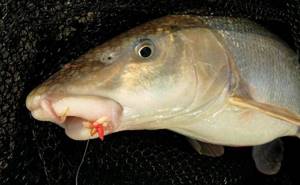
The diameter of the main line should be about 0.35-0.4 mm, while for leashes this figure is 0.25-0.3 mm. To keep the bait close to the bottom, the following methods are used:
- A sinker is tied to the end of the tackle, and leashes are attached above it;
- The weight is intermediate, the leads are in the bottom water horizon.
Description
The common barbel belongs to the carp family.
The fish attracts attention with its rather unusual body shape: elongated, similar in appearance to a torpedo. The barbel's snout has a similar shape as the body, the mouth is slightly extended forward and downward. This mouth structure makes it possible to find food at the bottom of the reservoir. A distinctive feature of Myron, another name for the fish, is two pairs of antennae with hypersensitivity.
The lips are thick, protecting against snags and gravel on the river bottom. The eyes are miniature, which is not natural for nocturnal predators. All fins are pink. The color depends on the place of permanent habitat: from olive green to dark, but always with a white belly and a pronounced lateral line. The dorsal fin consists of 8–9 rays, located quite high, at the level of the ventral fins. Myron can grow up to 80 cm, while its weight will be about 10 kg.
Catching barbel on a donk (feeder)
Fishing with tackle with both a blind and a sliding sinker is successfully practiced, plus the option with feeder feeders. The diameter of the fishing line for making leashes is 0.25-0.3 mm, for the main one – 0.4 mm. It is optimal to connect the leashes to the main line using swivels. Hooks - No. 6-7, with round eyes.
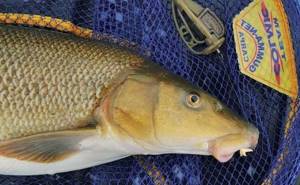
The traditional rod for hunting barbel is considered to be a heavy feeder type. The fish most often bites very sharply and hooks itself, so it is important to secure the fishing rod well so that the barbel does not simply drag it into the water.
Red worms in bunches, large crawlers, and pieces of hard cheese are used as baits for deep barbel fishing. At night, barbel fishing is more productive than during the day.
Large boilie-type baits are used on hair rigs. In any case, hooks should be selected taking into account the size of the nozzle.
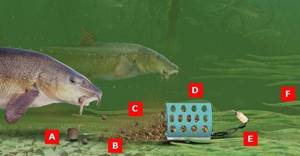
It is acceptable to use both monolithic and braided fishing lines for leashes. In the case of fishing line, the breaking load should be about 4 kg, for braid – 6 kg.
Part of the main bait must be added to the bait mixture. To fix the feeder, it is also better to use swivels with clasps; the knots are protected by a small rubber bead.
Varieties of longhorned beetle
The family is very numerous, many of its members are very different from each other and live in different conditions.
| Subspecies name | Characteristics |
| Ordinary | It has scales with a bronze tint, a fleshy snout and thick lips. Characterized by rapid growth. Often reaches a weight of about 10 kg |
| Sevan | Miniature. The average length of the body is 30 cm, and the weight is 300 g. It loves areas near the coast, since the main diet consists of mosquitoes, larvae and eggs of other freshwater animals. Lives in large numbers in Lake Sevan and the rivers flowing into it |
| Barbus cherry | A rare species of carp-like barbel, common in shallow streams of Sri Lanka and Ceylon. In Europe and other countries they are bred as decorative aquarium fish with small mustaches; they are listed in the Red Book |
| Aral | The largest variety of madder can be of gigantic size. It differs in that it leads not a sedentary, but a migratory lifestyle. Mainly found in the waters of the Syr Darya and Amu Darya. The dorsal fin is less pronounced. The whiskers are large, but not like those of a catfish. Sexual maturity occurs at 5-6 years of age. Spawns once every 1-2 years |
| Chanari | A beautiful individual with large golden scales. Reaches a length of 100-120 cm. Weight varies from 9 to 12 kg. Distribution area – Caspian Sea |
| Crimean | It lives in the rivers of the coast of the Crimean Peninsula, Turkey and Bulgaria. It is distinguished by its small size, rarely exceeding 40-50 cm. The color is dark bronze, sometimes with brown spots. |
| Caucasian | The Dagestan myron is found in the waters of the Caspian Sea. Reaches an average length of 40 centimeters. The scales are gray-reddish with dark spots, which are especially noticeable in young individuals. The lower fins are reddish |
| Kurinsky | In the Araks, Kura and tributaries of these rivers, small-sized motley barbels are common. Black-brown speckles cover their body and fins. The humpbacked species lives in the upper reaches of the Kura. Its peculiarity is its strongly curved snout and variegated color. |
Find out more:
Common loach and Amur loach: lifestyle, spawning and fishing
Spinning barbel fishing
The barbel is an omnivore, so it does not disdain even small fish. This makes it possible to catch it quite successfully with spinning rods, mainly with spinners or jig baits, which in color should resemble the colors of small fish living in the reservoir.
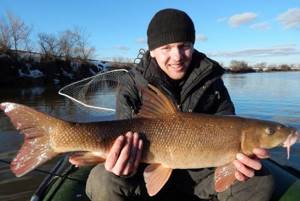
Spinning fishing is also carried out closer to the bottom, so it is better to first explore the local underwater terrain. Naturally, the rod used is quite powerful, with a test corresponding to the bait and a medium or medium-fast action.
Fishing for barbel
To catch madder, you need to use small baits. What is included in the fish’s diet attracts it most. Barbel is caught well on:
- crustaceans;
- leeches, snails, worms, maggots;
- soft cheese;
- cake, boilies;
- small fish feeding on the bottom;
- boiled potatoes;
- thickened blood.
You can use dung and earthworms. Steamed grains of cereal plants mixed with blood or milk are also used as bait. This fish loves bait, but in order not to make a mistake with the choice of bait, it is advisable to study the area and the inhabitants of the reservoir in advance.
For spinning
Fishing this way can be quite successful, considering the agility and agility of the fish. You need to choose a strong rod. It is better to use spinners that are small and spinning. They should imitate the small fish that live in the chosen location. It is advisable to equip the fishing rod with an inertia-free reel, and select a stationary sinker. There are several hooks on the leashes - 2-3 are enough.
Wiring is carried out above the bottom. The barbel is active at the moment of biting, and catching it the first time with a fishing rod is not easy if you have no experience. When biting there is a sharp jerk. At the moment of fishing, you must not allow any slack, otherwise the fish will fall off or go behind a snag or stone. It’s good to fish places with a spinning rod, and then use casts.

With snacks
Miron is excellently caught by baitfish, especially in the area of large concentrations. Donka fishing is the most common type of barbel fishing. In this case, the same equipment is used as for spinning, but the reel is replaced by a die (wooden or made of another material). The main tackle is thrown into the water, and the die is attached to the shore. Any type of donk can be used. Fishing is possible with a sliding load, with a stationary bait, and when moving along the bottom. The main secret of success is the perfect balance between the load and the rod.
To learn more:
Taimen: a valuable fish of the salmon family
In places with strong currents, where heavy sinkers are used, high sensitivity of the gear assembly is important, otherwise you may miss the moment of biting. It is best to fish with zakidushki at night, when the largest specimens are caught. While waiting for the main trophy, you can fish close distances with a picker and diversify your fishing.
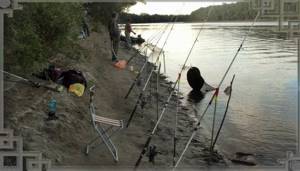
Traps
Where it is easy to catch barbel due to its abundance, traps can be used. This is a fairly easy, but difficult method. To catch fish with this tackle, you need to select or make it correctly. Standard traps are like a mesh barrel with a hole in the middle. There is bait inside, its smell attracts prey. Having fallen into a trap, she cannot get out of it.
You can build the tackle yourself. You need to take several metal rings of small diameter and cover them with mesh or rods. The result is a pipe, from one or both ends of which funnels made of the same material are inserted as on the sides. A window is installed in the middle of the trap for removing trophies. The bait is placed inside, wrapped in a fine mesh. The ideal place for such fishing is a hole or cliff near the shore. The barrel is tied to a stake fixed on land and thrown into the water.

